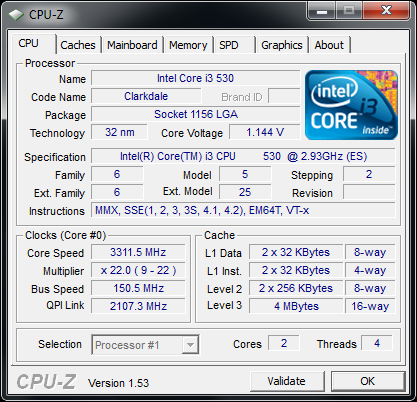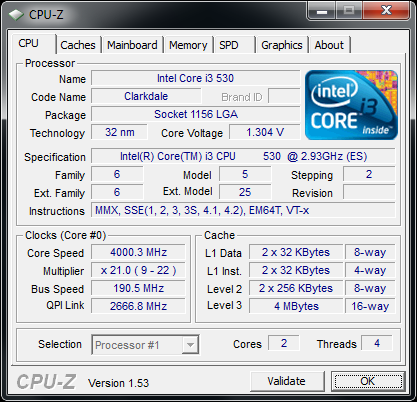The Intel Core i3 530 Review - Great for Overclockers & Gamers
by Anand Lal Shimpi on January 22, 2010 12:00 AM EST- Posted in
- CPUs
Overclocking the i3 - 4GHz with the Stock Cooler
I’ve become a fan of stock voltage overclocking over the past few years. As power consumption and efficiency has become more important, and manufacturing processes improved, how far you can push a CPU without increasing its core voltage appears to be the most efficient way to overclock. You minimize any increases in power consumption while maximizing performance. You really find out whether or not you’ve been sold a chip that’s artificially binned lower than it could have.
With Bloomfield, Intel hit a new peak for how far you can expect to push a CPU without increasing voltage. AMD followed with the Phenom II, but Lynnfield took a step back. Thanks to its on-die PCIe controller, Lynnfield needed some amount of additional voltage to overclock well. Clarkdale is somewhere in between. It lacks the crippling on-die PCIe controller, but it’s also a much higher volume part which by definition shouldn’t be as overclockable.
The Core i3 530 runs at 2.93GHz by default, with no available turbo boost. Without swapping coolers or feeding the chip any additional voltage, the most I got out of it was 3.3GHz (150MHz BCLK x 22). Hardly impressive.

I added another 0.16V to the CPU’s core voltage. That’s just under 14%. And here’s what I was able to do:

That’s 4GHz, stable using the stock heatsink/fan. Part of the trick to overclocking this thing was lowering the clock multiplier. Despite always keeping the QPI and memory frequencies in spec, lowering the clock multiplier on the chip improved stability significantly and allowed me to reach much higher frequencies.
I could push beyond 4GHz but that requires more voltage and potentially better cooling. With a stable 4GHz overclock, I was happy.
If you’ll remember from my review of the processor, my Phenom II X2 550 BE managed 3.7GHz using the stock cooler and a pound of voltage. Unfortunately it’s not enough to challenge the overclocked 530.
| CPU | x264 HD 3.03 - 2nd pass | 7-zip KB/s | Batman: AA | Dawn of War II | Dragon Age Origins | World of Warcraft |
| Intel Core i3 530 @ 4GHz | 18.4 fps | 2822 | 192 fps | 62.7 fps | 115 fps | 92 fps |
| AMD Phenom II X2 550 @ 3.7GHz | 10.4 fps | 2681 | 170 fps | 50.9 fps | 63 fps | 60.8 fps |
| AMD Phenom II X4 965 (3.4GHz) | 22.2 fps | 3143 | 196 fps | 54.3 fps | 109 fps | 74.1 fps |
Even an overclocked Athlon II X4 630 isn’t going to dramatically change things. It’ll still be faster in multithreaded applications, and still the overall slower gaming CPU.
If the Core i3 530 is right for you, overclocking is just going to make it more right.










107 Comments
View All Comments
marc1000 - Friday, January 22, 2010 - link
its interesting how close in performance the e8600 is to the i3... of course you loose some power efficiency but if you already have a good discrete GPU and a e8600 (or another older penryn clocked to e8600 levels, as it is my case), then none of the new CPU's are ground-breaking deals... they are faster, of course, but they are also expensive. not funny. going from a P4 to a Penryn was really great, but from a Penryn to these new ones... its just "good".Grooveriding - Friday, January 22, 2010 - link
Any chance of seeing some comparisons of this chip at 4ghz vs an i7 920 at 4ghz. I'd love to get an idea of how it compares clock for clock in gaming against the 1366 platform.Be interesting to see if it's better just getting this if you're a gamer.
cmdrdredd - Friday, January 22, 2010 - link
2.66Ghz i7 920 vs 2.93Ghz i3 530 is already there. The 2.66Ghz i7 is on average 10fps faster. Overclocking both to 4Ghz would have the same results if not even furthering the gap. Why? Because a slower clock speed CPU is already faster. So equaling the clock speed doesn't mean equaling performance.strikeback03 - Friday, January 22, 2010 - link
Even better, if they could add overclocked results they already have to Bench.ltcommanderdata - Friday, January 22, 2010 - link
I'm wondering if overclocking the IGP's shader units overclocks the memory controller as well since they are on the same die? That would help explain the good performance scaling. As well, was power consumption significantly different with the IGP at 1200MHz? If not, then Intel should definitely have clocked their IGPs higher. Catching up to current gen IGPs from nVidia and ATI is noteworthy for an Intel IGP, but presumably nVidia and ATI have their next gen IGPs right around the corner and Intel's IGP doesn't push new performance boundaries.IntelUser2000 - Monday, January 25, 2010 - link
No, the IGP is on its own clock domain. You can overclock the iGPU seperately from everything, even the base clock. On the motherboards which allow overclocking of the iGPU on Clarkdale, you don't have multiplier options, but a straightforward frequency adjustment.Abhilash - Friday, January 22, 2010 - link
sysmark is absurdAbhilash - Friday, January 22, 2010 - link
http://www.anandtech.com/bench/default.aspx?p=112&...">http://www.anandtech.com/bench/default.aspx?p=112&...karlkesselman - Friday, January 22, 2010 - link
hi,On page 2, Load Power Consumption you have i870 using less power than i750. This can't be. It's either a misprint or the "load" test doesn't fully stress the i870 or maybe some hardware misconfiguration.
Then there is the WoW test.
i750 has 92 fps
i530 has 77 fps
and
i530 (OC @ 4 GHz) has also 92 fps
We know that WoW only uses 2 cores so i750 must be having turbo boost enabled running @ 3.2 GHz. That explains why it gets 92 fps. But then the i530 @ 4 GHz gets the same fps. This is either a mistake (was the test running the same hardware?) or i530 is less efficient then i750 (at least running WoW; maybe because of the memory controller and/or the 8 MB L3 cache or both?).
Also in this case (WoW test) it would be interesting if we could see the power consumption during the test (i750 compared to i530).
Anand Lal Shimpi - Friday, January 22, 2010 - link
Our 870 has always used slightly less power than our 750 sample. A while ago Intel did away with having a single voltage for each product shipped. In my experience, the higher end chips are usually the ones that can run at the lowest voltages.All of our Core i7/i5 numbers are run with Turbo enabled, but remember that Clarkdale's memory performance isn't as good as Lynnfield. We see this manifest itself in more than just WoW. If you have the money, you're better off with Lynnfield. But at $113 you're at nearly half the price of the cheapest Lynnfield.
Take care,
Anand